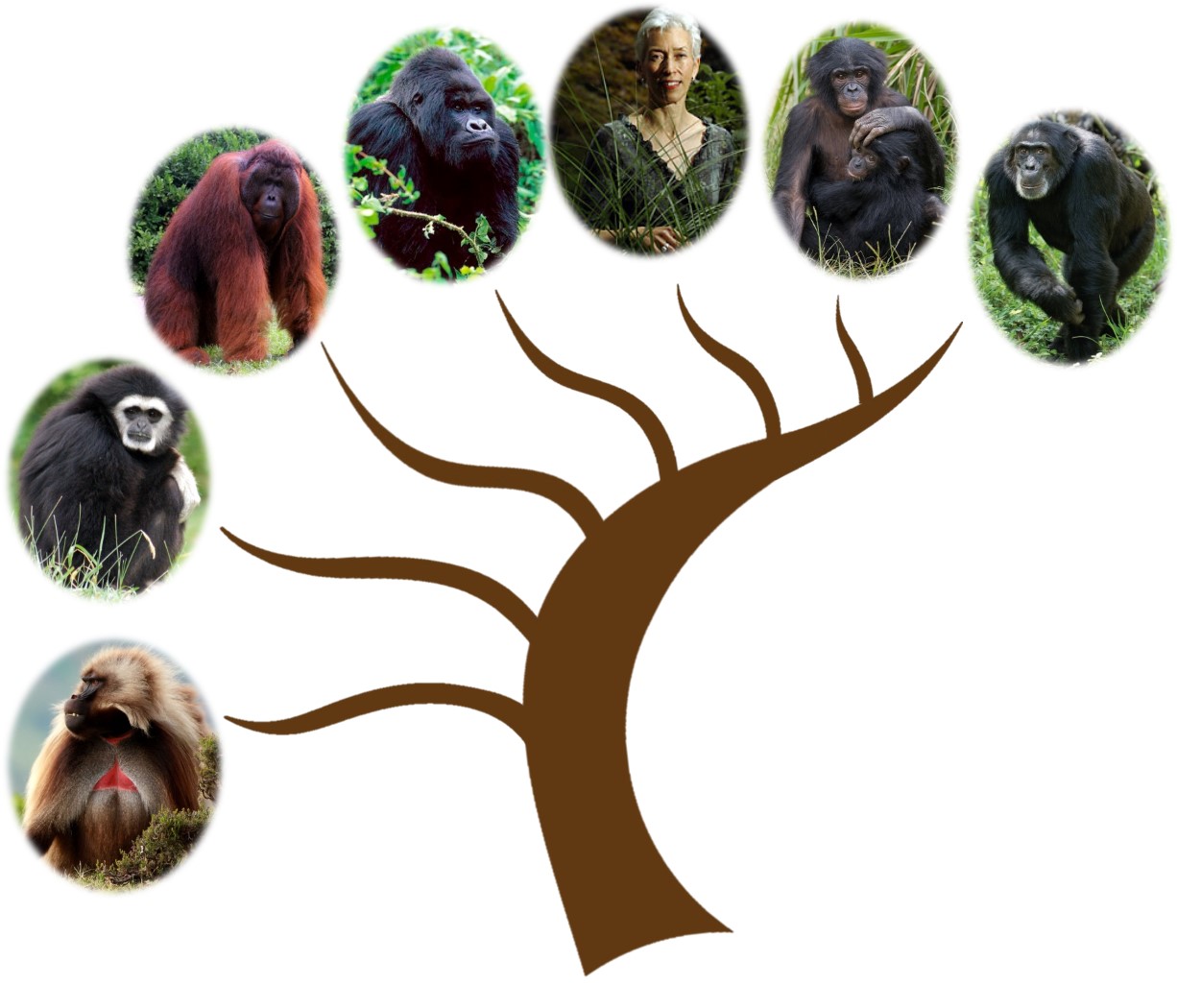 Our research on the evolution of Old World monkeys includes examining how lineages evolved with respect to environmental change, and exploring the reasons behind the “success” or “failure” of particular groups. This work is a continuation of Jablonski’s original focus of research in paleoanthropology. Current projects in this area are focused on descriptions of new fossil finds of colobine and cercopithecine monkeys in East Asia and Africa, in collaboration with Steve Frost (University of Oregon), Yohannes Haile-Selassie (Institute of Human Origins, Arizona State University, Cleveland Natural History Museum), and others.
Our research on the evolution of Old World monkeys includes examining how lineages evolved with respect to environmental change, and exploring the reasons behind the “success” or “failure” of particular groups. This work is a continuation of Jablonski’s original focus of research in paleoanthropology. Current projects in this area are focused on descriptions of new fossil finds of colobine and cercopithecine monkeys in East Asia and Africa, in collaboration with Steve Frost (University of Oregon), Yohannes Haile-Selassie (Institute of Human Origins, Arizona State University, Cleveland Natural History Museum), and others.
Relevant Publications:
Jablonski, N. G. (2021). Social and affective touch in primates and its role in the evolution of social cohesion. Neuroscience, 464, 117-125. doi:10.1016/j.neuroscience.2020.11.024
Sun, F.J., Wang, Y., Jablonski, N.G., Hou, S.K., Ji, X.P, Wolff, B., Tripati, A., Cao, J.Y., Yang, X. (2021) Paleoenvironment of the late Miocene Shuitangba hominoids from Yunnan, Southwest China: Insights from stable isotopes. Chemical Geology, 569, 120123. doi:10.1016/j.chemgeo.2021.120123
Jablonski, N. G., Ji, X., Kelley, J., Flynn, L. J., Deng, C., & Su, D. F. (2020). Mesopithecus pentelicus from Zhaotong, China, the easternmost representative of a widespread Miocene cercopithecoid species. Journal of Human Evolution, 146, 102851. doi:10.1016/j.jhevol.2020.102851
Ji, X., Youlatos, D., Jablonski, N. G., Pan, R., Zhang, C., Li, P., . . . Li, S. (2020). Oldest colobine calcaneus from East Asia (Zhaotong, Yunnan, China). Journal of Human Evolution, 147, 102866. doi:10.1016/j.jhevol.2020.102866
Khan, M. A., Kelley, J., Flynn, L. J., Babar, M. A., & Jablonski, N. G. (2020). New fossils of Mesopithecus from Hasnot, Pakistan. Journal of Human Evolution, 145, 102818. doi:10.1016/j.jhevol.2020.102818
Li, P., Zhang, C., Kelley, J., Deng, C., Ji, X., Jablonski, N. G., . . . Zhu, R. (2020). Late Miocene climate cooling contributed to the disappearance of hominoids in Yunnan Region, Southwestern China. Geophysical Research Letters, 47(11), e2020GL087741. doi:10.1029/2020gl087741
Kelley, E. A., Jablonski, N. G., Chaplin, G., Sussman, R. W., & Kamilar, J. M. (2016). Behavioral thermoregulation in Lemur catta: The significance of sunning and huddling behaviors. American Journal of Primatology, 78(7), 745-754. doi:10.1002/ajp.22538
Carbone, L., Alan Harris, R., Gnerre, S., Veeramah, K. R., Lorente-Galdos, B., Huddleston, J., . . . Gibbs, R. A. (2014). Gibbon genome and the fast karyotype evolution of small apes. Nature, 513(7517), 195-201. doi:10.1038/nature13679
Chaplin, G., Jablonski, N. G., Sussman, R. W., & Kelley, E. A. (2014). The role of piloerection in primate thermoregulation. Folia Primatologica, 85(1), 1-17. doi:10.1159/000355007
Frost, S. R., Jablonski, N. G., & Haile-Selassie, Y. (2014). Early Pliocene Cercopithecidae from Woranso-Mille (Central Afar, Ethiopia) and the origins of the Theropithecus oswaldi lineage. Journal of Human Evolution, 76, 39-53. doi:10.1016/j.jhevol.2014.05.003
Jablonski, N. G., Su, D. F., Flynn, L. J., Ji, X., Deng, C., Kelley, J., . . . Yang, X. (2014). The site of Shuitangba (Yunnan, China) preserves a unique, Terminal Miocene fauna. Journal of Vertebrate Paleontology, 34(5), 1251-1257. doi:10.1080/02724634.2014.843540
Ji, X., Jablonski, N. G., Su, D. F., Deng, C., Flynn, L. J., You, Y., & Kelley, J. (2013). Juvenile hominoid cranium from the terminal Miocene of Yunnan, China. Chinese Science Bulletin, 58(31), 3771-3779. doi:10.1007/s11434-013-6021-x
Liedigk, R., Yang, M., Jablonski, N. G., Momberg, F., Geissmann, T., Lwin, N., . . . Roos, C. (2012). Evolutionary history of the odd-nosed monkeys and the phylogenetic position of the newly described Myanmar snub-nosed monkey Rhinopithecus strykeri. PLoS ONE, 7(5), e37418. doi:10.1371/journal.pone.0037418
Jablonski, N. G., & Frost, S. (2010). Cercopithecoidea. In L. Werdelin & W. J. Sanders (Eds.), Cenozoic Mammals of Africa (pp. 393-428). Berkeley, CA: University of California.
Jablonski, N. G., & Chaplin, G. (2009). The fossil record of gibbons. In S. Lappan & D. J. Whittaker (Eds.), The Gibbons: New Perspectives on Small Ape Socioecology and Population Biology (pp. 111-130). New York: Springer.
McBrearty, S., & Jablonski, N. G. (2005). First fossil chimpanzee. Nature, 437(7055), 105-108. doi:10.1038/nature04008
Jablonski, N. G. (2003). The evolution of the tarsiid niche. In P. C. Wright, E. L. Simons, & S. Gursky (Eds.), Tarsiers: Past, Present, and Future (pp. 35-49). New Brunswick: Rutgers University Press.
Jablonski, N. G. (2002). Fossil Old World monkeys: The late Neogene radiation. In W. C. Hartwig (Ed.), The Primate Fossil Record (pp. 255-299). Cambridge, UK: Cambridge University Press.
Jablonski, N. G., Leakey, M. G., Kiarie, C., & Anton, M. (2002). A new skeleton of Theropithecus brumpti (Primates: Cercopithecidae) from Lomekwi, West Turkana, Kenya. Journal of Human Evolution, 43(6), 887-923. doi:10.1006/jhev.2002.0607
Jablonski, N. G., Whitfort, M. J., Roberts-Smith, N., & Xu, Q. (2000). The influence of life history and diet on the distribution of catarrhine primates during the Pleistocene in eastern Asia. Journal of Human Evolution, 39(2), 131-157. doi:10.1006/jhev.2000.0405
Jablonski, N. G. (1995). The phyletic position and systematics of the douc langurs of Southeast Asia. American Journal of Primatology, 35(3), 185-205. doi:10.1002/ajp.1350350303